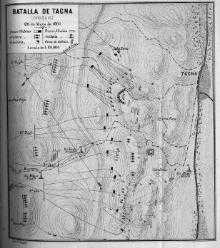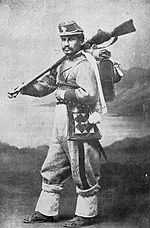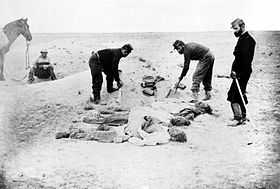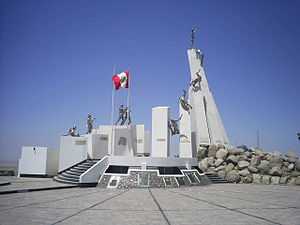Battle of Tacna
| Battle of Tacna | |||||||
|---|---|---|---|---|---|---|---|
| Part of War of the Pacific | |||||||
 Battle of Tacna according to Diego Barros Arana's "Guerra del Pacifico" | |||||||
| |||||||
| Belligerents | |||||||
|
|
| ||||||
| Commanders and leaders | |||||||
|
|
| ||||||
| Strength | |||||||
|
11,779[1] - 14,147[2] soldiers 37 cannons 4 Gatling guns[3] |
8,930[4] – 12,000[5] soldiers 16 cannons 7 Gatling guns | ||||||
| Casualties and losses | |||||||
| 2,200 casualties | 3,500 – 5,000 casualties | ||||||
The Battle of Tacna, also known as the Battle of Alliance Heights (Spanish: Batalla del Alto de la Alianza), effectively destroyed the Peru-Bolivian alliance against Chile, forged by a secret treaty signed in 1873. On May 26, 1880, the Chilean northern operations army led by General Manuel Baquedano González, conclusively defeated a Peru-Bolivian army commanded by Bolivian President, General Narciso Campero, after almost five hours of fierce combat. This battle took place at the Inti Urqu (Intiorko) hill plateau, a few miles north of the Peruvian city of Tacna. As a result, Bolivia was knocked out of the war, leaving Peru to fight the rest of the war alone. Also, this victory consolidated the Chilean domain over the Tarapacá Province, territory definitively annexed to Chile after the signing of the Tratado de Ancón (English: Treaty of Ancon), in 1884, which ended the war. Tacna itself remained under Chilean control until 1929.
Prologue
After the Bolivian government threatened to confiscate and clinch the Chilean Antofagasta Nitrate & Railway Company by decree on February 1, 1879, Chile sent troops to Antofagasta which took the city on February 14. Obliged by a secret cooperation treaty signed with Bolivia on February 6, 1873; Peru was forced into the conflict. Despite Peruvian efforts to avoid a confrontation, Chile — by then aware of the secret pact — declared war on the Allies on April 5. Once started, the conflict initially developed on the sea, due to the strategic relevance of its domination. The Chilean Navy had serious problems with its Peruvian counterpart at the beginning, as the ironclad Huáscar, commanded by Admiral Miguel Grau Seminario scored several victories at Iquique and other engagements. An eight-month chase conducted by the Chilean fleet concluded with the capture of the Huáscar and the death of Peru's highest naval figure in a decisive encounter at Angamos on October 8.
With the sea assured, the Chilean high command moved the theatre of operations to land. The next step was the invasion of the Tarapacá Department.
Accordingly, the Chilean army launched an amphibious operation at Pisagua on November 2, successfully pushing the Allies inland and isolating the strongholds of Arica and Iquique. The Chileans continued to move into the Peruvian department seeking for water supplies to sustain the emplacement of Pisagua. A scout mission encountered and crushed two allied squadrons at Pampa Germania on November 6. Two weeks later, on November 19, 6,500 men Colonel Emilio Sotomayor defeated 9,000 troops under General Buendía at San Francisco Hill, near Dolores. This action was marked by the failed march of Daza with the bulk of Bolivian army. This is known as the Camarones betrayal.
These victories made the Chileans too confident. A poorly planned attack over Buendía's army remains at Tarapacá confronted 4,000 Peruvians against 2,200 Chileans under Col. Luis Arteaga. The battle ended with almost 30% of Arteaga's men dead, wounded of captured.
The Allies
Despite his victory, Buendía left the entire Peruvian department under Chilean control. The Allies withdrew to Arica in an extenuating and perilous march, and lost almost 2,000 men.[6] When arrived, Buendía was removed from his commission and court-martialed.
Additionally, the lack of results generated popular discontent in Peru and Bolivia. This was determinant for the deposition of the President of Perú, Mariano Ignacio Prado, and his Bolivian counterpart, Hilarión Daza. Both were deposed and replaced by Nicolás de Piérola and General Narciso Campero, respectively. Also, the loss of the Tarapacá Department stopped the earnings of the saltpeter trade, making the war financial weight heavier for the Allies.
The Chileans
After the defeat of Tarapacá, the Chileans went quiet for some time. The government in Santiago believed that with the loss of Tarapacá, Perú would be inclined to sign a truce, allowing to keep the recently gained Tarapacá territory as war compensation.[7] Also, Chile saw how civilian volunteers increased the army contingent up to 10,000 men in less than six months.[8] Besides, the control of Antofagasta meant an extra cash-flow from the saltpeter exportation, making possible to purchase weapons, clothes, food and other war materials the expanding army would require, easing the burden of war expenditures.[9]
Allied Army
The Allies had about 11,000 men between Tacna and Arica;[10] also, the new Bolivian President Narciso Campero managed to send another infantry division to Tacna. But, there were disagreements about how to face the enemy between Admiral Lizardo Montero and Piérola's deputy, Pedro del Solar, wasting precious time in internal disputes whilst the Chileans marched towards Tacna. Meanwhile, the Peruvian vessel Unión broke through the blockade on Arica, delivering supplies, medicines and shoes to the port garrison.[10] The army present in Tacna had about 10,000 men and thirty one cannons — six Krupp cannons, six machine guns, two La Hitte cannons, seven 4" strayed cannons and 12" Blackey cannons.[7] The Allied infantry had to fight with different types of rifles, making it harder to supply them.
Chilean Army
.jpg)
The Chilean High Command planned a landing at Ilo and Pacocha to scout the country and to gain knowledge of the Allies status. Following two previous incursions, 10,000 men were unshipped at Ilo. By the time of these events, Gen. Erasmo Escala resigned to his commission as Commander in Chief due to constant arguments with War Minister Rafael Sotomayor. The latter appointed General Manuel Baquedano Gonzalez, a Peru-Bolivian Confederacy war veteran, who had the sympathies and respect of the soldiers as his successor.[11] Since the beginning of the conflict, the infantry was equipped with Comblain and upgraded Gras rifles, using the same type of bullets. The artillery had thirty-seven cannons — twenty Krupp cannons and seventeen mountain cannons.[10]
Preliminary moves
A Chilean expeditionary force disembarked at Ilo on December 31, to take the port and eliminate resistance in the region. Under Lt. Col. Aristides Martínez, the Chileans took control of the town and severed the telegraph to Moquegua, allowing Martínez to move with liberty. Afterwards, the expedition took the train to Moquegua, which surrendered the next morning. Then, Martínez returned to Ilo and sailed back to Pisagua on January 2. With this successful campaign, Sotomayor decided to attack Tacna and Arica with the entire army, leaving Moquegua alone.[10]
A massive landing took place between February 18 and February 25. Three divisions, strong in about 9,500 men, disembarked in a first echelon whereas another one was unshipped a few days later. On the 27, the Chilean Navy began the bombardment of Arica, where the Huáscar's new captain Manuel Thompson, died.
On March 8, another Chilean expedition of 900 soldiers under Colonel Orozimbo Barbosa was sent to Mollendo. Ten days later, Gen. Campero's 5th Division reached Tacna, assuming control of the Allied Army. By the end of the month, the Peruvian stronghold of Los Angeles hill,[12] -a position considered unbreakable by the Allies- fell to Baquedano. Shortly after, the Chileans marched across the desert to Tacna, but the artillery had to be re-embarked and shipped to Ite; while on April 9, the Peruvian port of El Callao was set under blockade.
On May 20, Minister Rafael Sotomayor died of a stroke at Las Yaras. The Chilean President Anibal Pinto appointed José Francisco Vergara as the new War Minister in Campaign.
Whilst the Chilean Army developed in the Tacna Department, the Allies had their own problems. Montero wanted to wait for the Chileans at Tacna, but Col. Eliodoro Camacho supported the idea to march and ambush them at the Sama river valley, easing the communications with Arequipa.[13] Trying to avoid any confrontation, Gen. Campero traveled to Tacna to take charge, assuming his command on April 19. On the night of May 25, Campero's troops tried to ambush the Chileans at Quebrada Honda, but the darkness and the mist prevented the Allies from doing so, forcing their return to Tacna for defense preparations.[10]
The battle
Battlefield
The Intiorko plateau is an arid and soft-sloped terrain located a few miles north from Tacna, becoming an excellent shooting ground. It has on the rear a series of little sand accumulations that allowed the concealment of reserve units behind them. The flanks are protected by the Sama-Tacna road from the east, and to the west by an almost impossible to walk terrain, where no artillery could ever been placed, and a harsh field for infantry or cavalry movement.[14]
Allies plan and distribution

The Allied plan relied on the terrain tactical advantages, so the strategy was to wait the attack from a strong position. So, the army was set on the southern edge of the Intiorko plateau, deployed in a 3 km. defensive line. The troops did not make any defenses or trenches, apart from little sand defences for the artillery on their right wing.
Campero divided his army into three major sectors, with the right wing under the command of Lizardo Montero, the centre led by Col. Castro Pinto, and the left flank commanded by Col. Eliodoro Camacho.[10] The Southern Peruvian Army and the Bolivian Army added up twenty one battalions and eight machine guns with nine cannons, plus eight cavalry squadrons.
Chilean plan and troop deployment
Two plans were presented before Baquedano. The first one was a flanking manoeuvre on the Allied right proposed by War Minister Vergara. On the other hand, Col. Velasquez had the idea to engage the entire enemy front in a simultaneous and frontal charge, taking advantage of the defensive line thinness. Hence, the troops couldn't be moved from one point to another, avoiding the reinforcement of weaker points generated during the battle. Besides, the lack of trenches and fortifications would make this breaking easier.[14]
Baquedano decided to use Velasquez' plan.[15] Thus, the infantry split into five divisions, with the 1st Division of Col. Santiago Amengual right next to the 2nd Division of Col. Francisco Barceló on front. Right behind them was Col. Jose Amunátegui's 3rd Division and Col. Orozimbo Barbosa's 4th Division deployed on a third line, and behind these two was the reserve of Col. Mauricio Muñoz.[16] Velasquez' artillery had thirty-seven cannons and four machine guns, and the cavalry was composed of three regiments, with a fraction detached to the 2nd Division and the rest with Baquedano's chief staff. The Chilean army presented at Tacna a total of sixteen battalions, three cavalry regiments and thirty-seven cannons.
The beginning

The battle began with useless artillery cross-fire, because the projectiles bured in the sand and didn't explode. According to Velázquez' plan, around 10 am Amengual marched against Camacho followed by Barceló who was to charge the Allied center. Both divisions advanced under heavy fire, but failed to engage combat at the same time. Amengual entered into battle first,[17] allowing Campero to send in Herrera's division, followed by the Alianza and Aroma battalions from the right flank reserve.[18] When Barceló approached to Castro Pinto, the 2nd Line Regiment noticed the Peruvian Zepita Battalion — unit which took its banner at Tarapacá — in front of it, and charged driven by vengeance, disregarding superior orders to detain.[19] Until now, only 4,500 soldiers had assaulted the Allied front.[17]
The Allies counter-attack
By 11 am, Camacho had several units lined up, among them the Amarillos, Libres del Sur and Viedma battalions. A brief calm due to a reorganization in the attacking divisions made him believe in a Chilean vacillation, and sent his soldiers to charge. However, an unseen maneuver performed by Velásquez' artillery proved deadly and decimated the Allied left by entire ranks; soon entered into battle, the new Allied battalions were obliterated by a precise and concentric fire, killing about 80% of their men within the hour. Camacho urged for reinforcements, and the Allies' elite units, the Colorados and Aroma battalions, were sent in his aid. Once arrived, the reserve counterattacked Amengual[20] forcing him to retreat since the soldiers exhausted their ammunition.[21] The Esmeralda, Santiago and Navales battalions retreated under heavy fire. Barceló faced the same problem, and retreated as well with heavy casualties, as his Atacama Regiment lost almost half of its personnel in this maneuver. Meanwhile, Baquedano ordered Amunátegui to reinforce Amengual and Barceló, and moved the artillery forward.[14]
Chilean breakthrough
To ease the retreat, War Minister Vergara ordered Yávar’s grenadiers to charge. The cavalry was received in square formations and rejected, but successfully stopped the Allied advance, giving Amengual and Barceló enough time to regroup and refill their weapons. When Yávar retreated, Amunátegui’s division arrived, and along with Amengual caught the Bolivians in a heavy cross fire and tore them to pieces. Both divisions advanced covered by the closer artillery fire, and forced the Allies back to their initial positions.[14]
The Chilean infantry continued pushing forward until both armies were at close range, and rushed the defensive line in a melee.[14] The Peruvian Victoria Battalion gave under the pressure and withdrew, splitting the Allied lines.

Ending
Meanwhile the Allied left and centre were being broken, Barbosa's division engaged the weakened Allied right, encountering light resistance and outflanked the position. Once the Peruvians were outmaneuvered and forced back, Barboza captured the artillery batteries on the sector.[16] Baquedano sent in the reserve, which engaged the Allied right flank combined with the remains of the Atacama Battalion. With this final move, the entire defensive front collapsed, and the Allies left the battlefield after 5 hours. While the Allies retreated to Tacna, Amengual chased them until reaching the city. Later Tacna was shelled in order to force the surrender, and finally Col. Santiago Amengual entered into the city around 18:30.
Aftermath

The Chilean Army had 2,200 casualties. Amengual's, Barceló's and Amunátegui's divisions, which added up 6,500 men, had 1,639 dead and wounded. Barbosa's division lost 15% of its force. The Chilean reserve almost did not fight, having only 17 wounded.[22] The Atacama and Santiago regiments lost almost 50% of their effective force. Also the 2nd Line, Navales and Valparaíso regiments had severe losses. The 2nd Line Regiment banner lost at the battle of Tarapacá was found on a church in Tacna by Ruperto Marchant Pereira.
The Allies had casualties estimated between 3,500 and 5,000 men. The Bolivian Army lost 23 officers from Major to General. The "Colorados" Battalion had only 293 survivors, while the Aroma Battalion — also known as "Amarillo" – lost 388 soldiers, since these units chose to fight to the end instead of retreating.[10] The Peruvian army lost 185 officers, and more than 3,000 soldiers died. Accordingly to a communication of Solar to Piérola, only 400 Peruvian men escaped from the battle.[23]
Military and political results
The Chilean victory had a decisive impact upon the Allies. Gen. Campero withdrew to Bolivia, taking the road to Palca,[24] meanwhile Montero retired to Puno, passing through Tarata.[10]
The battle broke the Alliance. The crippled Bolivian army didn't participate in the war again, forcing Bolivia to accept its complete defeat. On Peru's side, its army had to fall back north, isolating the garrison at Arica, which was taken two weeks later.
For Chile, the victory allowed it to concentrate its efforts on conquering Lima, since was clear to the Chilean leadership that only the fall of the Peruvian capital could end the war.
See also
Notes
- ↑ Ejército de Chile, Dirección General de Movilización Nacional. "Las Relaciones Nominales". Retrieved 2008.
- ↑ according to official sources "Historia del Ejército de Chile, Volumen 6" p. 86 by "Estado Mayor General del Ejército de Chile"
- ↑ Mackenna Vicuña "Historia de la campaña de Tacna y Arica, 1879-1880"
- ↑ according to Nicolás de Pierola Archives cited by Jorge Basadre
- ↑ Gonzalo Bulnes. "Batalla de Tacna" (PDF). Retrieved 2010.
- ↑ La Guerra del Pacífico en imágenes, relatos, testimonios, p. 169
- ↑ 7.0 7.1 Harun Al-Rashid. "La Batalla de Tacna". Retrieved 2008.
- ↑ When the war started, the Chilean Army had only a 2,995 men strength, divided into six battalions and three cavalry regiments
- ↑ La Guerra del Pacífico en imágenes, relatos, testimonios, p. 173
- ↑ 10.0 10.1 10.2 10.3 10.4 10.5 10.6 10.7 Basadre, Jorge. "La verdadera epopeya". Archived from the original on 10 October 2008. Retrieved 2008.
- ↑ La Guerra del Pacífico en imágenes, relatos, testimonios, p. 181
- ↑ La Guerra del Pacífico en imágenes, relatos, testimonios, pp. 181-183
- ↑ Pelayo Mauricio. "Allied war council act at Tacna, April 7, 1880". Retrieved 2008.
- ↑ 14.0 14.1 14.2 14.3 14.4 Ejécito de Chile. "Batalla de Tacna". Retrieved 2008.
- ↑ Centro de Estudios e Investigaciones Militares del Ejército de Chile. "General Jose Velasquez Borquez' biography". Retrieved 2008.
- ↑ 16.0 16.1 Ojeda Frex, Jorge. "La Batalla de Tacna". Archived from the original on 2007-10-14. Retrieved 2008.
- ↑ 17.0 17.1 La Guerra del Pacífico 1879-1884, p. 170
- ↑ "Lizardo Montero's official report of the battle of Tacna". Retrieved 2008.
- ↑ La Guerra del Pacífico en imágenes, relatos, testimonios, p. 192
- ↑ Efraín Choque Alanoca. "Battle of the Stop of the Alliance". Retrieved 2008.
- ↑ "Biografía Ignacio Carrera Pinto". Retrieved 2008.
- ↑ La Guerra del Pacífico 1879-1884, p. 177
- ↑ La Guerra del Pacífico 1879-1884, p. 176
- ↑ "Pedro del Solar's official report of the battle of Tacna". Archived from the original on 6 October 2008. Retrieved 2008.
Bibliography
- Bulnes, Gonzalo (1911). La Guerra del Pacífico 1879 - 1884. Editorial del Pacífico.
- Mellafe, Rafael; Pelayo, Mauricio (2004). La Guerra del Pacífico en imágenes, relatos... testimonios. Centro de Estudios Bicentenario.
- Ejército de Chile. "Batalla de Tacna". Retrieved 2008.
- Museo Histórico Militar de Chile. "Batalla de Tacna o del Alto de la Alianza". Retrieved 2008.
- Harvard College Library. "La Batalla de Tacna". Retrieved 2008.